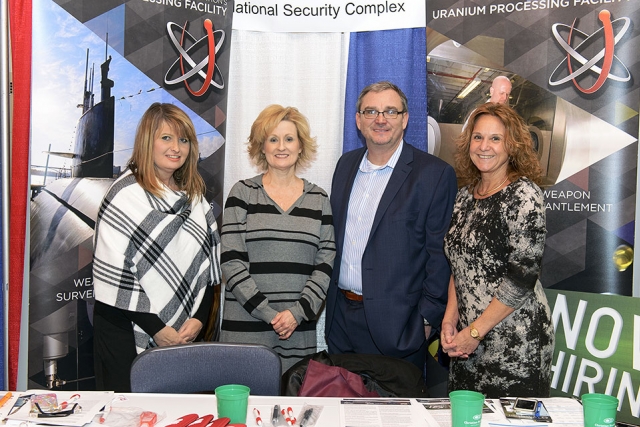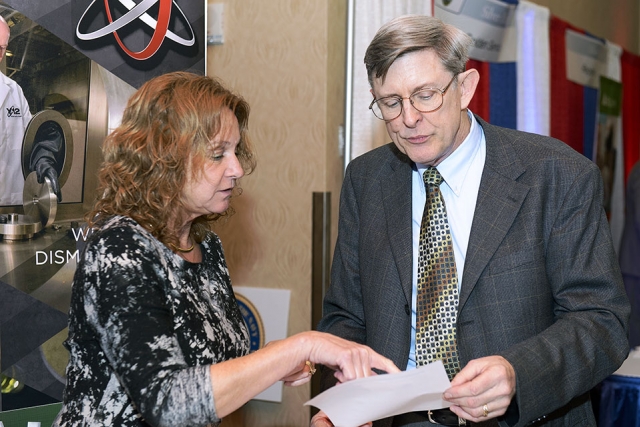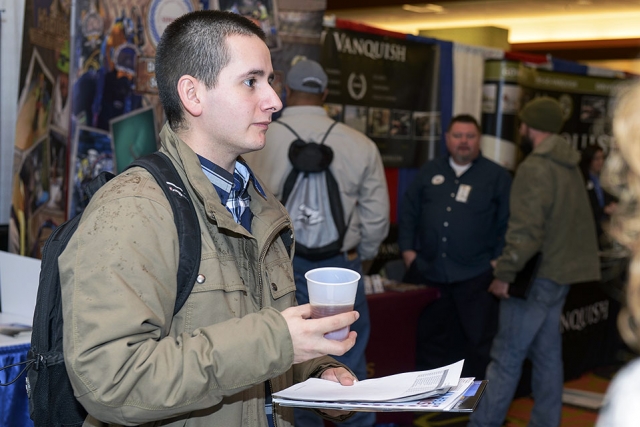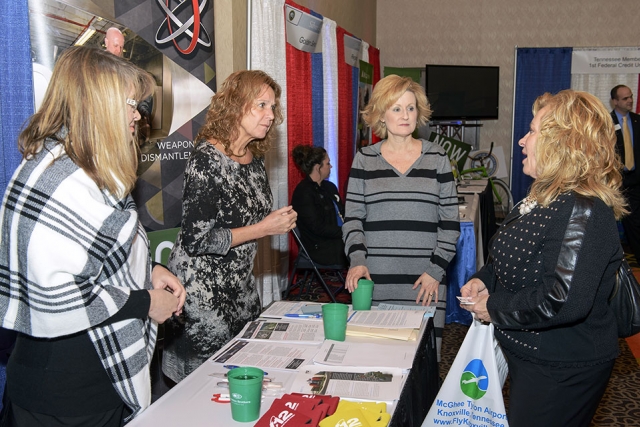Y-12 Blog
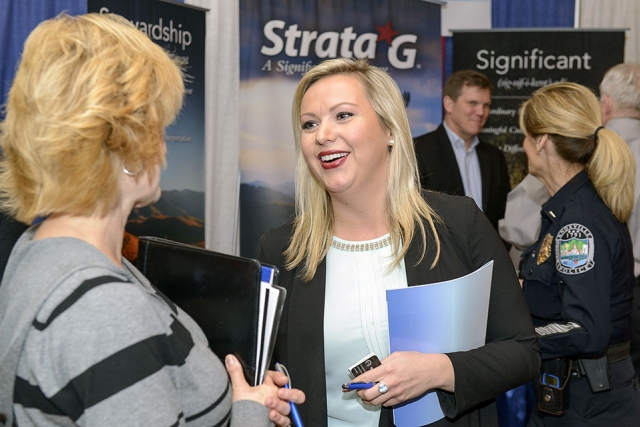 Y-12 Small Business Program Manager Lisa Copeland (left) interacts with a participant at the Tennessee Veterans Business Association Expo.
Y-12 Small Business Program Manager Lisa Copeland (left) interacts with a participant at the Tennessee Veterans Business Association Expo.
Y-12 has a long history of supporting veterans — both as employees and as suppliers. Through participation in the Tennessee Veterans Business Association Expo, Consolidated Nuclear Security, LLC is able to reach both groups.
TVBA’s mission is tailor made for Y-12’s interests. The association focuses on training entrepreneurs, assisting with business development and finding rewarding employment for all veterans.
TVBA Chairman and Founder Jonathan Williams said the expo began in 2012 with the goal of showcasing local veteran-owned businesses. The concept quickly evolved into a business-to-business trade show to include companies that liked to work with veteran-owned businesses.
With all these companies in the room and veteran unemployment at a record high, Williams said, “We quickly realized this would also be a great opportunity for a veteran-focused career and education fair.”
This was the fifth year for the expo, and Williams said they’ve all been “wildly successful,” averaging 120 exhibitors each year.
“Y-12 is a huge part of the expo,” said Williams. “Not only does Y-12 use many veteran-owned small businesses as contractors, but they also employ many veterans.”
Veterans are a vital part of the Y-12 workforce. More than 500 Y-12 employees have voluntarily identified themselves as veterans. Lisa Copeland, Y-12 Small Business program manager, said, “We have a goal of obtaining 4% from veteran-owned small businesses and 3% from service-disabled, veteran-owned businesses. Events like the TVBA Expo help us identify qualified candidates for our needs.”
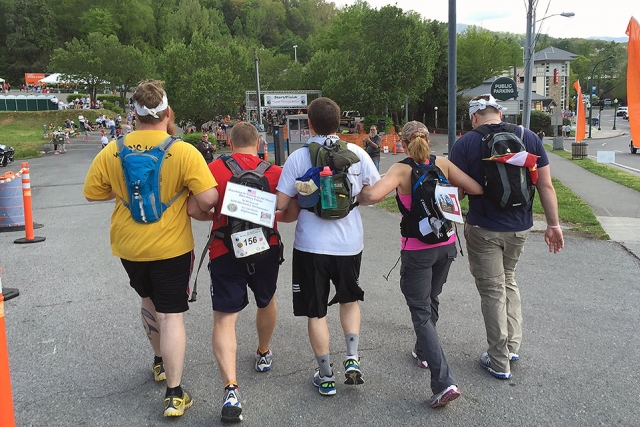 UPF’s five-person team won the Team Civilian Light Full March award for completing a relay in under eight hours. From left: Jim Schumacher, Matt Crookshanks, Brad Kramer, Tina Sowers and Jamie Lesko at the finish line.
UPF’s five-person team won the Team Civilian Light Full March award for completing a relay in under eight hours. From left: Jim Schumacher, Matt Crookshanks, Brad Kramer, Tina Sowers and Jamie Lesko at the finish line.
Nine UPF staff, including a combat veteran, honored fallen soldiers and their families by participating in the ninth annual Mountain Man Memorial March April 22‑23.
Participants in the event honor the sacrifices of fallen American service members and their families by walking 26.2 miles to simulate walking in service members’ shoes. Proceeds provide scholarship grants to Gold Star family members and donations to the University of Tennessee Army and Air Force ROTC programs and the American Legion Post #2 in Knoxville.
UPF staff who participated were Joe Bucci, Jamie Lesko, David Tran, Matt Crookshanks, Jim Schumacher, Brad Kramer, Tina Sowers, Bill Sonnenburg and Noah Carlson. Five members of the team — Lesko, Crookshanks, Schumacher, Kramer and Sowers — won the Team Civilian Light Full March award for completing a relay in under eight hours.
Carlson, a U.S. Army combat veteran of the Iraq conflict, marched in honor of four soldiers he knew who died in Iraq in 2005: SPC Justin Blake Carter, SGT Monte S. Ruth, 1LT Michael J. Cleary and SPC Richard D. Naputi.
“I was honored to see so many people from the UPF project supporting the families of fallen soldiers,” Carlson said.
The UPF group marched in honor of the Gold Star families of U.S. Army Sgt. Michael Joe Beckerman and Airman Nathaniel Henry McDavitt.
Established after World War I to provide support for mothers who lost sons or daughters in the war, membership in the Gold Star Mothers Club is open to any American woman whose child has died in the line of duty. The group provides emotional support to members, does volunteer work with veterans and veterans hospitals, and fosters patriotism and respect for members of the U.S. Armed Services.
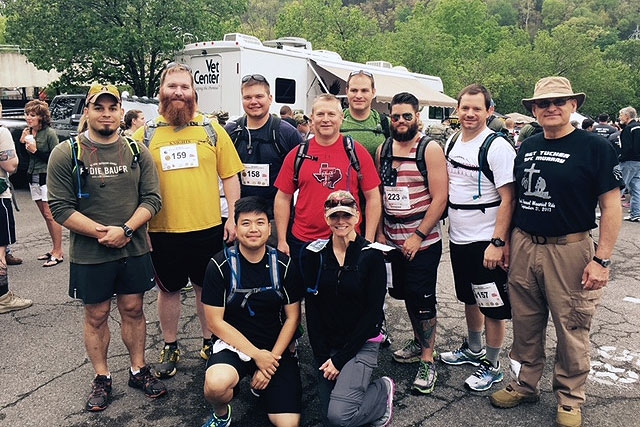 UPF team members (front row, from left) David Tran and Tina Sowers and (back row, from left) Noah Carlson, Jim Schumacher, Jamie Lesko, Matt Crookshanks, Bill Sonnenburg, Joe Bucci, Brad Kramer and Mike Lassiter.
UPF team members (front row, from left) David Tran and Tina Sowers and (back row, from left) Noah Carlson, Jim Schumacher, Jamie Lesko, Matt Crookshanks, Bill Sonnenburg, Joe Bucci, Brad Kramer and Mike Lassiter.
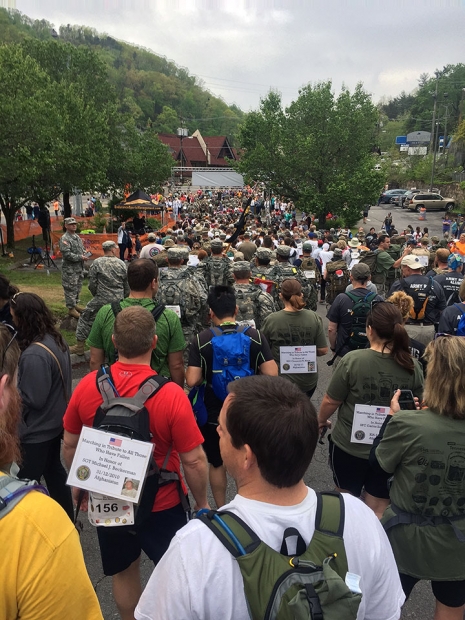 UPF team members wait to begin the Mountain Man Memorial March.
UPF team members wait to begin the Mountain Man Memorial March.
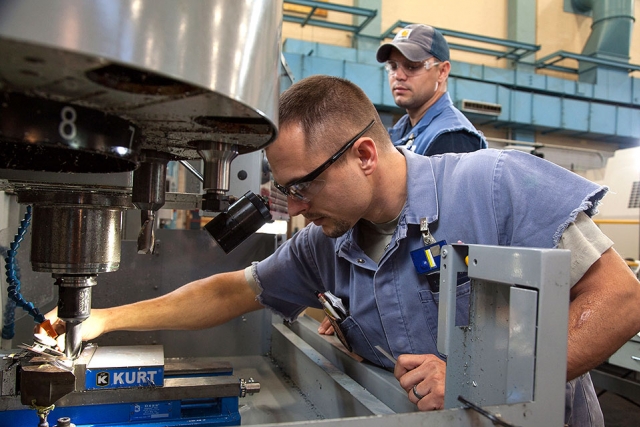 Apprentice machinist John Bryant, foreground, uses dial calipers to measure a feature of a part while his twin brother Jeff Bryant, also an apprentice machinist, looks on.
Apprentice machinist John Bryant, foreground, uses dial calipers to measure a feature of a part while his twin brother Jeff Bryant, also an apprentice machinist, looks on.
Twins Jeff and John Bryant’s lives have tracked a similar course. Both joined the military after high school, then both became security police officers at Y‑12, and now they are apprentice machinists at the site. For the brothers, it’s not their parallel career paths they find intriguing but the connection they discovered to their past.
It wasn’t until they entered the apprenticeship program that they found out their grandfather also was a machinist. “He was a tool and die maker,” said John Bryant. “We never knew that. Now we have a deeper appreciation for our grandfather and for the trade.”
The brothers are in their last year of a four‑year apprenticeship program and are on track to graduate in August. They are grateful for the on‑the‑job learning opportunity. Through a combination of classroom training in manufacturing technology and machining practices at Pellissippi State Community College and hands‑on shop work at Y‑12, they are learning to operate tools, such as lathes and milling machines, to cut and produce precision parts.
“I’m happy for the opportunity to learn a trade, a craft, that I never dreamed I’d be able to do,” said Jeff Bryant. “I get a lot of satisfaction in taking a blueprint and a piece of rough stock and turning it into a part.”
Greg Justice and Mike Patt, journeymen who worked with Jeff and John Bryant, respectively, enjoy passing their skills and knowledge to apprentices who will carry on the site’s tradition of machining excellence. “The apprenticeship program is an avenue for people to move up in skill positions,” Justice said.
Patt added, “We need apprentices who will learn skills to continue to operate the plant at the level we have throughout the years.”
The Bryants are more than willing to take up the mantle. “We are absolutely absorbing this,” John Bryant said. “Once the older generation retires, if our country still needs our skill set, our knowledge, we’ll be here.”
Each brother has always felt a strong need to serve his nation; it’s been the driving force in their career choices.
After high school, Jeff Bryant joined the Marine Corps where he trained using all kinds of weapons systems, eventually becoming a field artillery section chief in charge of a 12‑man team firing a 155-mm Howitzer. After the Marine Corps, he joined the Tennessee Army National Guard as a military police officer, deploying once to Iraq, before becoming a security police officer at Y‑12.
John Bryant followed a similar but different path. He joined the Army and then the Army Reserve. As a combat engineer on his second deployment in Iraq, he was wounded by enemy fire and received the Purple Heart, something he’s hesitant to talk about.
“There are so many other guys who work here who have done a lot more in the Armed Forces than me,” he said. “I don’t want to pretend to be something I’m not. I’m not here to show ribbons and stars.”
After his military service, he too became a security police officer at Y‑12. “Jeff and I had alternating schedules as SPOs, but now we work together as apprentices. We’re extremely blessed to have served our country in the military, as SPOs and now as apprentices. That’s pretty big for us, to have jobs that directly affect our nation’s security.”
“We feel like everything has come full circle for us,” Jeff Bryant said. “Our grandfather has passed now, but I think he would be proud of us.”
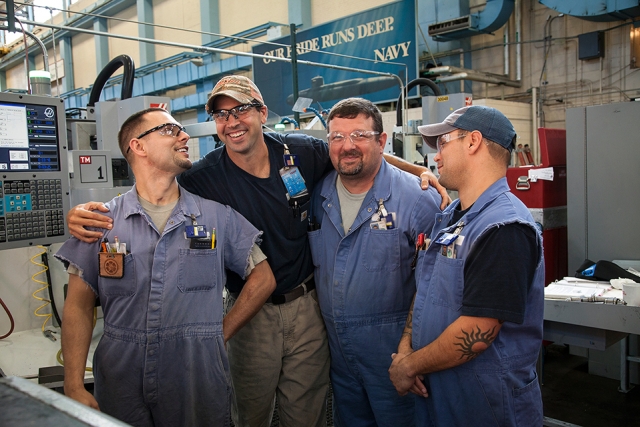 From left: Apprentice machinists John Bryant, Justin Dupas, Brice Graham and Jeff Bryant share a laugh and camaraderie on the shop floor.
From left: Apprentice machinists John Bryant, Justin Dupas, Brice Graham and Jeff Bryant share a laugh and camaraderie on the shop floor.
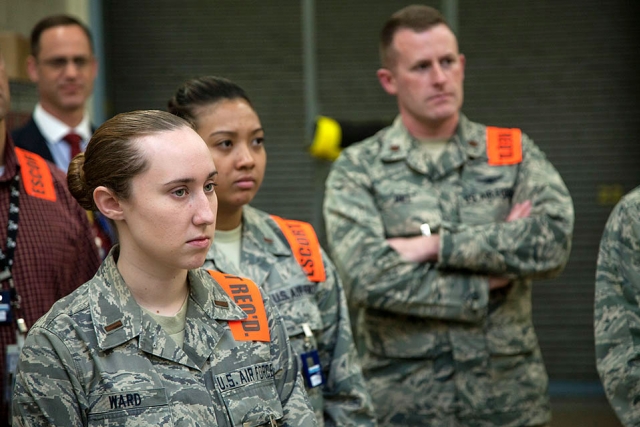 A team from Malmstrom Air Force Base in Montana recently toured Y‑12’s production facilities to see the processing and assembly of nuclear weapon components.
A team from Malmstrom Air Force Base in Montana recently toured Y‑12’s production facilities to see the processing and assembly of nuclear weapon components.
Major Jeff Hill believes the United States’ nuclear deterrent is as relevant today as it was at the height of the Cold War, despite the drastically changing landscape of global terrorism and warfare.
“This is the one weapon the president uses every single day,” said Hill, chief of Quality Assurance for the 341st Maintenance Group at Malmstrom Air Force Base. “Other countries make decisions every day based on the fact that we’ve got these nuclear weapons, and they’re ready to go.”
But the deterrent, Hill noted, is only effective as long as the U.S. and its nuclear capabilities are credible. That begins at Y‑12.
“In order to achieve that deterrence, you’ve got to absolutely know that these will work,” Hill said. “Everything you do here at Y‑12 every day leads to that capability. We have tremendous faith and assurance that if we launch a weapon, it will work — every time.”
Hill and a group of his colleagues from Malmstrom visited Y‑12 recently for briefings and tours through the plant’s uranium processing and storage and weapons assembly and disassembly facilities to learn more about nuclear warheads and their inner workings — something they otherwise might not have a chance to see.
“Most missile leaders and operators are just taught broad strokes of how the weapons work,” said Lt. Steven Heizer. “But we want to become nuclear experts, so the opportunity to see the different parts and learn about what Y‑12 does is extremely helpful.”
Hill was instrumental in setting up the trip, a collaboration between Y‑12 Production and Oak Ridge National Laboratory’s Global Security Directorate. “These visits show the big picture of our community as a whole,” Hill said, noting both this visit and Y‑12’s January visit to Malmstrom. “Whether you’re DOE or DOD, we’re all one big nuclear community trying to accomplish the same thing: deterrence.”
As Hill and his colleagues toured Y‑12’s production facilities, their confidence in these weapons grew.
“It’s really reassuring, as the one who might have to launch one of these one day, to know that you guys know what you’re doing,” said 1st Lt. Michael Kraft, chief of ICBM training products at Malmstrom. “It was really empowering to learn the development process and see that there are a lot of inspections, analyses and surveillances that go into ensuring these weapons will work.”
Heizer was impressed even more by the people he met, though, than by the processes and systems. “A lot of us are young and don’t remember the Cold War, so it’s great to see that people are excited and proud to be working at Y 12,” Heizer said. “The weapons become more real when we can see the different components, meet the people who make them and realize we’re all on the same team.”
Hill left with the same notion. “Every person we’ve seen has a distinct sense of ‘I’m here, and this is my mission.’ For us to see that just gives us a greater appreciation for the work you do,” he said. “We never question whether these will work — and neither does the other guy.”
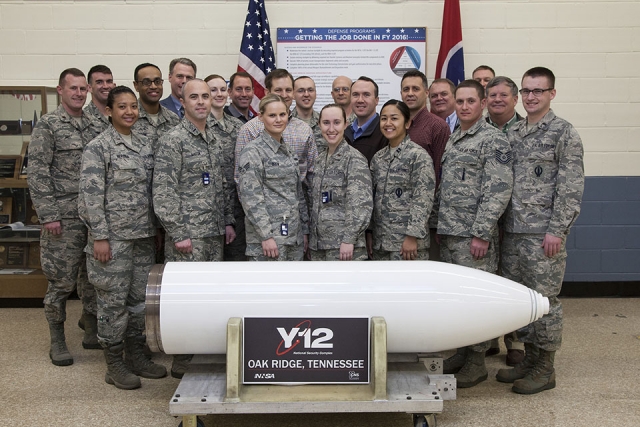 Malmstrom Air Force Base visitors.
Malmstrom Air Force Base visitors.
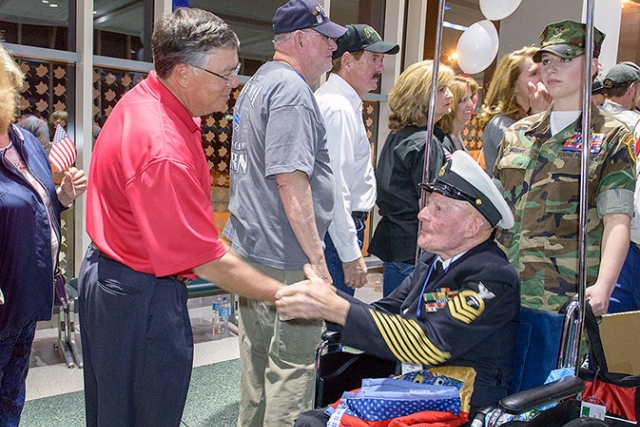 CNS’s Gene Patterson welcomes home an East Tennessee veteran who participated in the 20th HonorAir Knoxville flight.
CNS’s Gene Patterson welcomes home an East Tennessee veteran who participated in the 20th HonorAir Knoxville flight.
April 13, 2016, was another memorable day for HonorAir Knoxville as 125 war veterans traveled to Washington, D.C., to visit the memorials built to honor their sacrifices. The one-day trip represented the 20th flight for HonorAir, which has flown more than 2,600 East Tennessee veterans to our capital and back, with all expenses paid.
Hundreds of family members and supporters were on hand at McGhee Tyson Airport to greet the veterans who served in World War II, Korea and Vietnam. Among the World War II veterans was James Seal, who is 100 years old and the oldest veteran to have ever traveled with HonorAir.
A contingent from the Consolidated Nuclear Security, LLC Y-12 National Security Complex was in attendance as the flight returned. Y-12 has been greeting the returning veterans since 2011.
Linda Neal, who works in Business Management at Y-12, was there. “Greeting the HonorAir veterans is so meaningful to me because my father was in the Marine Corps for 27 years,” she said. “Shaking hands and talking to these military men brought tears to my eyes because they reminded me so much of him.” She added, “Having grown up on a military base, I saw how the men who served in Vietnam were treated by the civilians. It was awesome to see them finally get the welcome home they deserved.”
Flight 20 consisted of 47 Vietnam veterans, 25 World War II veterans and 53 Korean War veterans. CNS has been a sponsor of the flights for several years.
Lisa Roberts, who works in Safeguards, Security, and Emergency Services, has celebrated the veterans’ homecomings since 2014. Flight 20 was her fourth time to thank the veterans.
“I attend the HonorAir homecomings because it’s a way to celebrate our veterans and a chance to thank them for their service,” Roberts said. “I have family that served in Vietnam, my father fought in the Korean War, my Aunt served as a nurse in WWII, and my grandfather fought in the Spanish-American War. To me, it’s a great way to honor my family who’ve served our country well. HonorAir is an awesome event and one that I’m very proud to be a part of.”
HonorAir Knoxville is the brainchild of founder Eddie Mannis, president of Prestige Cleaners. The next scheduled flight is planned for fall 2016. In addition, the organization announced that, on June 8, it will take a flight of Vietnam veterans only on a special trip.

